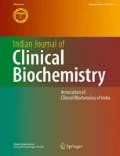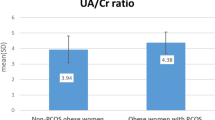Abstract
Polycystic ovary syndrome (PCOS) is a common endocrinological disorder among women of the reproductive age group with long term sequelae which include diabetes mellitus, hypertension and CAD. The present study was conducted to evaluate the association of leptin—an adipokine playing an important role in carbohydrate metabolism and markers of insulin resistance among women with PCOS. Sixty diagnosed cases of PCOS as per Rotterdam criteria were enrolled in this study after informed written consent. Insulin resistance was estimated using the homeostatic model assessment-insulin resistance (HOMA-IR). HOMA-IR was calculated as the product of the fasting plasma insulin value (mU/ml) and the fasting plasma glucose value (mg/dl), divided by 405 and HOMA β was calculated as 360 × [insulin]/([glucose] − 63) % (glucose in mg/dl). Estimation of serum leptin levels was done by ELISA using leptin ELISA kit from (DRG). A positive correlation of serum leptin levels was observed with markers of insulin resistance. Multiple regression analysis with HOMA-IR as dependent variable demonstrated a statistically significant contribution of fasting insulin levels. This study highlights the role of leptin in alterations in carbohydrate metabolism in patients with PCOS.
Similar content being viewed by others
References
Stein I, Leventhal M. Amenorrhea associated with bilateral polycystic ovaries. Am J Obstet Gynecol. 1935;29:181.
Azziz R, Woods KS, Reyna R, Key TJ, Knochenhauer ES, Yildiz BO. The prevalence and features of the polycystic ovary syndrome in an unselected population. J Clin Endocrinol Metab. 2004;89:2745–9.
Zawadzki J, Dunaif A. Diagnostic criteria for polycystic ovary syndrome: towards a rational approach. In: Dunaif A, Givens JR, Haseltine FP, Merriam GR, editors. Polycystic ovary syndrome. Oxford: Blackwell Scientific Publications; 1992. p. 377–84.
Franks S. Polycystic ovary syndrome. N Engl J Med. 1995;333:853–61.
Hoeger KM. Role of lifestyle modification in the management of polycystic ovary syndrome. Best Pract Res Clin Endocrinol Metab. 2006;20:293.
Zhang YY, Proenca R, Maffei M, Barone M, Leopold L, Friedman JM. Positional cloning of the mouse obese gene and its human homolog. Nature. 1994;372:425–32.
Leroy P, Dessolin S, Villageois P, Moon BC, Friedman JM, Ailhaud G, et al. Expression of ob gene in adipose cells and regulation by insulin. J Biol Chem. 1996;271:2365–8.
Brzechffa PR, Jakımıuk AJ, Agarwal SK, Weitsman SR. Serum immunoreactive leptin concentrations in women with polycystic ovary syndrome. J Clin Endocrinol Metab. 1996;84:4166–9.
Mendonça HC, Montenegro RM, Foss MC, Silva De Sa MF, Ferriani RA. Positive correlation of serum leptin with estradiol levels in patients with polycystic ovary syndrome. Braz J Med Biol Res. 2004;37:729–36.
Fritz MA, Speroff L. Clinical gynaecology endocrinology and infertility. 8th ed. New delhi: Wolters Klumer, Lippikott Williams, Wilkins Publisher; 2011.
Godarzi MO, Korenman SG. The importance of insulin resistance in polycystic ovary syndrome. Fertil Steril. 2003;80:255–8.
Mancini F, Cianciosi A, Marchesini RG, Facchinetti F, Cesare B, Aloysio D. Endothelial function and its relationship to leptin, homocysteine, and insulin resistance in lean and overweight eumenorrheic women and polycystic patients. Fertil Steril. 2009;91:2537–44.
Erturk E, Kuru N, Savci Tuncel E, Ersoy C, Imamoglu S. Serum leptin levels correlate with obesity parameters but not with hyperinsulinism in women with polcystic ovary syndrome. Fertil Steril. 2004;82:1364–8.
Remsberg KE, Talbott EO, Zborowski JV, Evans RW, Pemu K, et al. Evidence for competing effects of body mass, hyperinsulinemia, insulin resistance, and androgens on leptin levels among lean, overweight, and obese women with polycystic ovary syndrome. Fertil Steril. 2002;78:479–86.
Author information
Authors and Affiliations
Corresponding author
Rights and permissions
About this article
Cite this article
Nasrat, H., Patra, S.K., Goswami, B. et al. Study of Association of Leptin and Insulin Resistance Markers in Patients of PCOS. Ind J Clin Biochem 31, 104–107 (2016). https://doi.org/10.1007/s12291-015-0499-8
Received:
Accepted:
Published:
Issue Date:
DOI: https://doi.org/10.1007/s12291-015-0499-8




